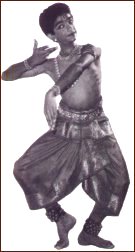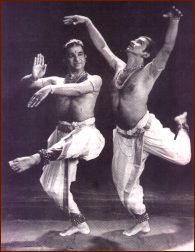The Concept of the Male Dancer
From "A Dancer on Dance" written by V.P. Dhananjayan, published by Bharata Kalanjali
Indian dance is very popular today.
In popular parlance, it is the in-thing. There are different classical
Indian Dances, the most famous of which are Bharatanatyam, Kathakali, Odissi,
Kathak, Manipuri and Kuchipudi. These dances arouse public enthusiasm
and consequently such performances now draw knowledgeable and highly sophisticated
audiences, compared to those of past decades.
Amidst all this renaissance of interest
in Dance somehow a wrong notion has crept into the minds of our people
that dancing is meant only for women. The historical and socio-cultural
factors that led to this misconception are many. It is a fact
that for many decades, dance has been a near monopoly of women, be it in
the South or the North. Nowadays the male dancer is a rare phenomenon
and it happens that a section of the public looks down upon him.
Men may become dance teachers, they may provide nattuvangam and musical
accompaniment and do everything else needed to make it possible for women
to dance, but if they themselves don ankle bells and start to dance, they
are put down as effeminate upstarts in an exclusively female domain.

The traditional, meaning hereditary,
dance teachers, usually refuse to teach men; and the less said about women
teachers in this regard the better. This is very surprising since
the very concept of Dance is masculine in origin. Nataraja, meaning the
king of performers, the patron deity of dancers is male and according to
Indian scripture, the originator of Dance.
Parallels from nature also, can
be drawn showing that the male is more oriented towards the movements that
appear dance-like to us. The dance of the peacock, the gait of the
male swan or the stance of a lion.
The writer of Natya
Sastra and all its great commentators have been men. So have been
the foremost masters and composers of this medium of dance.
In folk and tribal dancing, the performers
are generally men while women are mostly excluded from magical and ritual
dancing. Thus the present social prejudice against the male dancer is entirely
without basis. It is interesting to note that the Natya Sastra, the
ancient Indian science of dramaturgy views dance as a male prerogative.
The stylistic elements of its techniques are described under 'Tandavalakshana',
the male overtones of which term are obvious. 'Lalitha Nrithyam',
the soft and gentle type of dance is only a part of 'Kaisiki Vritti' one
of the four dramatic presentations described in texts (the others Arabhati,
Satvathi and Bharathi).
It is believed that Parvathi, the consort
of Nataraja Siva, introduced the 'Lasya' or the delicate-feminine mode
into Dance. Yet as compared with her consort Nataraja, her dance
finds an insignificant place in literature, over-shadowed, as it were,
by the extreme and all-pervasive vigour of Nataraja's 'Tandava'.
Apart from this divine couple there are quite a few personages from our
mythology who are associated with the art of dancing in one way or the
other and among these, invariably men outnumber women. Krishna, the
frolic-some stealer of hearts is a dancer. Arjuna was conscripted
by Indra to judge the better amongst the celestial dancers, Rambha and
Urvasi. And while in exile, Arjuna taught dance as Brihannala to
Uttara. Kamadeva, Ganesha, Anjaneya and even Ravana were all supposed
to be masters of music and dance. Bharata and his hundred illustrious
sons who propagated this art form throughout our country can also be cited
as evidence from the Itihasas.

According to the more substantial
evidence from literature, men have been predominantly associated with dance
from ancient times. Bharata, the author of Natyasastra, Nandikeswara
the author of Abhinayadarpana, Dhananjaya who wrote Dasarupaka, and many
other writers and commentators, including Dattila and Kohala alluded to
by Nandikeswara in the introduction of his oft referred treatise, were
men.
So was Jaya Senapathi,
of Nrittaratnavali and Ilango Adigal, the author of Silappadikaram (Tamil
literary work) which devotes a chapter exclusively to an erudite discussion
of music and dance as it existed then.
The heritage of Indian Dance embraces
several forms which can be broadly classified as classical, folk and tribal.
Apart from the major classical styles, there are at least a dozen other
forms so highly developed that they deserve to be ranked along with the
principal styles mentioned earlier. An interesting feature of these
diverse styles is that, most of them were originally intended for men alone.
It is only recently that women have been taking part in them.
Looking back again to scriptures, Dance
originally existed as dance dramas. Kathakali, Bhagavathamela, Kuchipudi,
Krishnattam, etc., were all presentations of drama through the medium of
dance. With this vast back-ground supporting the existence and virtually
the pre-eminence of the male dancer, it is highly regrettable that so many
misconceptions continue today. There are some people who hold that
dancing should be delicate and graceful, even if a man is the performer.
Some teachers go to the extent of coercing their male students to imitate
their female counterparts in the departments of dress, ornamentation and
presentation.
The cumulative effect of these misconceptions
of the public and the mis-direction of the teachers is such that very few
men are taking to dance, fewer still making the grade to become professionals.
This apart, there is immense social and parental pressure on boys to become
doctors and engineers so that a lucrative career is assured. With
all this psychological stigma, social approbation and economic sanctions,
it is not surprising that dance is fast becoming more oriented towards
the fair sex. On the other hand, this is something akin to damning
with faint praise, if a boy is delicately featured and minces to match,
he is considered a fit candidate for dance lessons.
Unless these trends are reversed
by educating public opinion, the dignity and prestige of this magnificent
art form will be lessened, probably for ever, by excluding the male element
from it. Let us hope it will not come to pass.